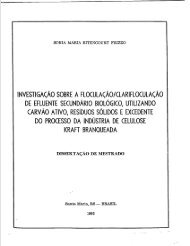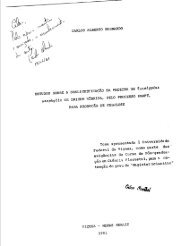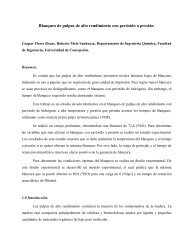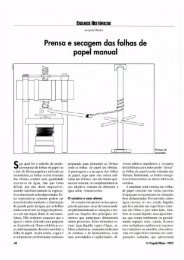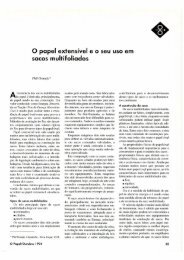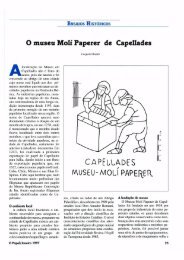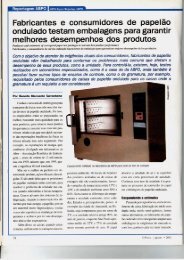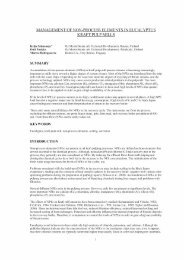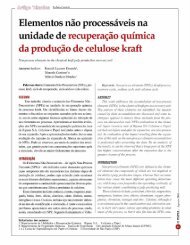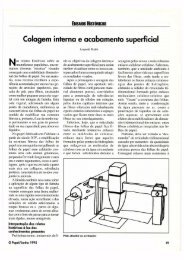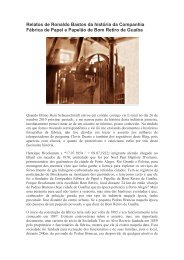O Eucalipto: um século no Brasil (The Eucalypt - Celso Foelkel
O Eucalipto: um século no Brasil (The Eucalypt - Celso Foelkel
O Eucalipto: um século no Brasil (The Eucalypt - Celso Foelkel
Create successful ePaper yourself
Turn your PDF publications into a flip-book with our unique Google optimized e-Paper software.
Atualmente, <strong>no</strong>s troncos dos 3,5 milhões de hectares de cultivo de eucalipto existentes<br />
<strong>no</strong> <strong>Brasil</strong>, estão seqüestrados 196 bilhões de toneladas de carbo<strong>no</strong>. O cálculo é<br />
de Paulo Muller, do IPEF. Ele conta que esse carbo<strong>no</strong> foi absorvido como dióxido de<br />
carbo<strong>no</strong>, o gás que tanto preocupa o mundo, porque sua liberação em excesso provoca o<br />
aquecimento global, que ameaça modificar drasticamente as condições de vida na terra. O<br />
eucalipto, como qualquer vegetal clorofilado, absorve o carbo<strong>no</strong> para crescer e o número<br />
citado leva em conta apenas os 200 m³ de madeira por hectare, do eucalipto cultivado para<br />
ser cortado entre seis e oito a<strong>no</strong>s de idade, visando a produção de celulose para papel e<br />
painéis de madeira reconstituída.<br />
Há mais, muito mais carbo<strong>no</strong> seqüestrado sobre o solo, na forma de folhas, galhos e casca,<br />
que é incorporado ao solo quando essa matéria orgânica é absorvida pelo terre<strong>no</strong>. Mais<br />
carbo<strong>no</strong> é seqüestrado ainda <strong>no</strong>s eucaliptais de mais idade, plantados para a produção<br />
de tábuas, e <strong>um</strong> total não mensurável de carbo<strong>no</strong> <strong>no</strong>s postes, pisos, dormentes, batentes,<br />
portas e papel produzidos a partir do eucalipto.<br />
É essa imensa capacidade de seqüestrar carbo<strong>no</strong> que faz os países desenvolvidos, grandes<br />
poluidores, olharem com tanta esperança para o <strong>Brasil</strong>. É que se conseguirmos triplicar<br />
o cultivo de eucalipto até 2010, como prevê a Associação <strong>Brasil</strong>eira de Florestas Plantadas<br />
(ABRAF), será reduzida significativa parte do efeito negativo das usinas termelétricas, da<br />
queima de gasolina e outros derivados do petróleo, além de outras atividades industriais<br />
que liberam carbo<strong>no</strong> na atmosfera.<br />
O E U C A L I P T O - U M S É C U L O N O B R A S I L<br />
120<br />
Some 196 billion tons of carbon are currently sequestered in the trunks of the 3.5<br />
million hectares of eucalypt plantations currently spread all over Brazil. <strong>The</strong><br />
figure was calculated by IPEF’s Paulo Muller. He explains that this carbon was<br />
absorbed as carbon dioxide, the gas that concerns the world because when released<br />
in excess it causes the global warming that threatens to drastically change the Earth’s<br />
life conditions. <strong>Eucalypt</strong>, however, as any chlorophyll-bearing plant, absorbs carbon<br />
to grow, and the above-mentioned figure only takes the 200 m³ of wood per hectare, of<br />
eucalypt that is planted to be cut at six to eight years of age to produce pulp for paper<br />
and reconstituted wood panels into account.<br />
<strong>The</strong>re is much more carbon sequestered on the soil, in the form of leaves, twigs and<br />
bark, which is incorporated into the soil when it absorbs this organic matter. Even more<br />
carbon is sequestered in the older eucalypt plantations, planted for board production,<br />
and an unmeasurable amount of carbon is in posts, flooring, sleepers, door posts,<br />
doors and paper produced based on eucalypt.<br />
It is this huge capacity to sequester carbon that leads developed countries, huge polluters,<br />
to look to Brazil with so much hope. <strong>The</strong> reason is that if we are able to triple the<br />
eucalypt plantations by 2010, as the ABRAF predicts, a significant part of the negative<br />
effect caused by the thermoelectric plants, by burning gasoline and other oil derivatives,<br />
as well as by other industrial activities that release carbon to the atmosphere will<br />
be reduced.




